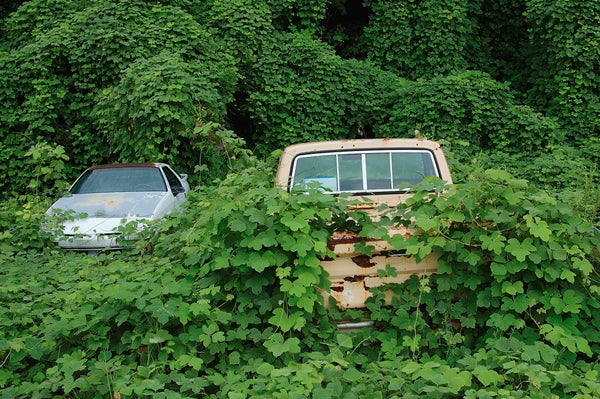This article was published in Scientific American’s former blog network and reflects the views of the author, not necessarily those of Scientific American
Kudzu (scientific name: Pueraria lobata) is now often seen as a blight on the southern landscape of the United States, but like many invasive plants it was first introduced deliberately. Following its debut at the Japanese pavilion of the 1876 Philadelphia Centennial International Exhibition, the vine was quickly adopted to shade the gardens and porches of the American South and adorn them with its showy, fragrant flowers.
But kudzu did not escape from the garden into the wild all on its own; rather, it was extensively promoted by the Soil Conservation Service as a bulwark against erosion and a remedy for the environmental and economic troubles brought on by cotton and tobacco monoculture. These government efforts resulted in the planting of approximately three million acres of kudzu by 1946. Massive transplantation to a favorable soil and climate, combined with the lack of competitors, pests, diseases and land uses that kudzu had encountered in its native East Asian habitats, enabled the rapid-growing vine to carpet vast swaths of land.
From an exotic rarity, kudzu thus morphed into a ubiquitous and uncanny interloper. Drawing on his memories of World War II, the poet James Dickey, of Deliverance fame, published in the New Yorker in 1963 a poem entitled “Kudzu” that opens with the announcement of a Japanese invasion and goes on to paint a Gothic picture of a land under siege: “The night the kudzu has/Your pasture, you sleep like the dead…. Silence has grown Oriental.”
On supporting science journalism
If you're enjoying this article, consider supporting our award-winning journalism by subscribing. By purchasing a subscription you are helping to ensure the future of impactful stories about the discoveries and ideas shaping our world today.
The poet’s disturbing metaphors are a reminder that the eradication of foreign plants and concomitant celebration of native species has sometimes gone hand in hand with troubling ideologies of racial or cultural purity. It may be more accurate to refer to invasive behaviors, rather than invasive plants, since a plant that is harmful in one context may be productive in another. That is very much the case with kudzu.
Even as kudzu gained notoriety in the sixties and seventies, it found some defenders. In a 1977 documentary by Marjie Short that was nominated for an Academy Award, Jimmy Carter championed the vine in opposition to Dickey, who famously called it “a vegetal form of cancer.” That same year, The Book of Kudzu: A Culinary and Healing Guide, by William Shurtleff and Akiko Aoyagi, recorded the plant’s uses in Japan—for food, cloth and medicine—and proposed their adoption on American soil.
A 19th-century Japanese treatise on kudzu, Seikatsu roku, recently acquired by the Dumbarton Oaks rare book collection in Washington, D.C., reveals just how valuable kudzu was in its East Asian habitat. Written by agricultural innovator Ōkura Nagatsune (1768–c.1860) and illustrated by a student of the famed printmaker and painter Hokusai, the treatise celebrates kudzu as a “useful thing … in useless places,” able to flourish in depleted soils and steep mountain sides. The book brings together detailed methods and instructions for collecting and processing the plant for food and textile manufacture. The author appeals to regional administrators to scale up kudzu production as a safeguard against famine and to promote innovative regional applications as a spur to economic development.
Ōkura is well aware of kudzu’s role in traditional Chinese medicine, where the root extract has long been used as a treatment for alcohol intoxication as well as hypertension, coughs and colds. Modern science is beginning to produce clinical evidence of puerarin’s effect against excessive alcohol consumption and alcohol damage. Other studies suggest that the plant and its extracts may inhibit HIV-1 entry into cell lines, remove toxins from the ground and build biohybrid circuits that contribute to solar power in the developing world.
Ōkura might also take heart at the imaginative uses of the plant in East Asia today. In Korea (where since at least the 17th century agricultural manuals included kudzu in their instructions for famine relief and country living) the plant is used in over a hundred different products, from face masks to prepackaged cold noodles. And in Japan, it is an essential element of regional specialty items ranging from Kakegawa handbags to Kumamoto medicinal extracts to crispy kanemochi.
Plants have many personalities depending on their specific environmental and cultural contexts. Kudzu has at different times served as a medicine, a foodstuff, an ornament, an economic resource, an ecological solution and an invasive pest. A work like Ōkura’s Seikatsu roku opens windows into the rich cultural histories of plants. Through efforts such as the Plant Humanities Initiative, we can learn more about their complexity and revive our curiosity about their properties and future applications.
